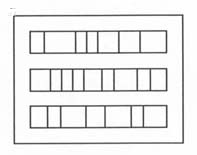The objective of this system is to form a standard poly-cell type cells. The elements of the circuit are cells with various width and uniform height. A standard cell consists of plural cell blocks constructed from a line of cells. The object of this system is to minimize the total wiring length used to connect each cell and terminal in the LSI.

Example of standard cell